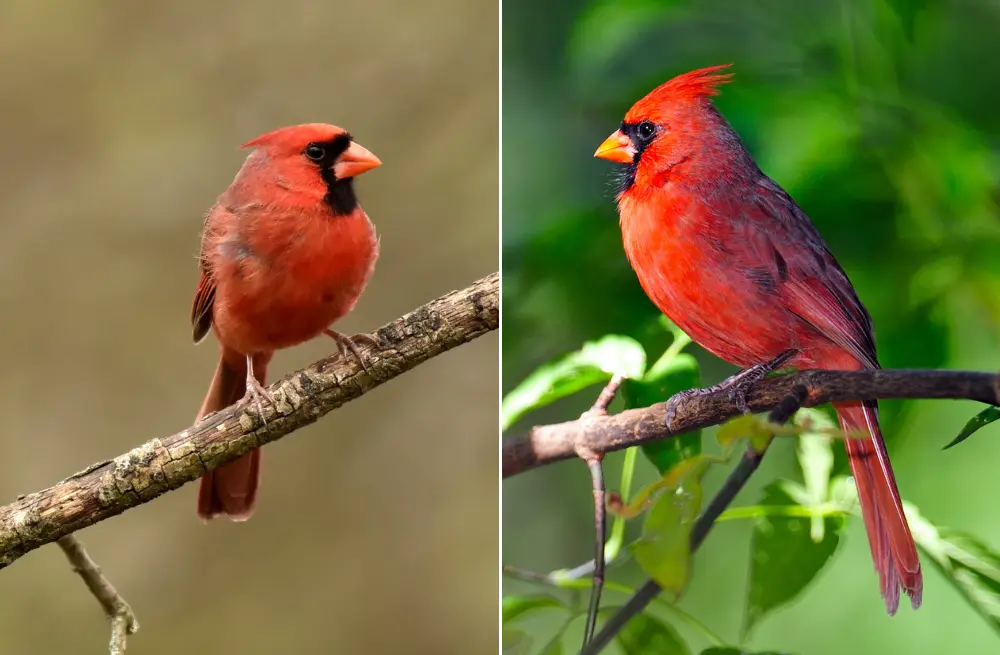In the heart of South America’s lush rainforests, a vibrant flash of crimson flits among the verdant canopies—the Red-masked Parakeet (Psittacara erythrogenys).
This striking avian species, adorned with its captivating red face and head, is a living testament to the region’s rich biodiversity.
From its appearance to its habitat and behavior, the Red-masked Parakeet is a fascinating subject for bird enthusiasts and nature lovers alike.
Quick information
| Feature | Description |
|---|---|
| Scientific Name | Psittacara erythrogenys |
| Common Name | Red-masked Parakeet |
| Habitat | Tropical rainforests, montane cloud forests |
| Range | Western Ecuador, northwestern Peru |
| Size | Approximately 13 inches (33 cm) |
| Appearance | Emerald-green plumage with a striking red facial mask |
| Breeding Season | During the rainy season in their rainforest habitats |
| Nesting Sites | Tree cavities, abandoned woodpecker holes |
| Clutch Size | Usually 3 to 5 eggs |
| Parental Care | Both parents share incubation and chick-rearing |
| Altitude Range | 1,000 to 3,000 meters (3,280 to 9,842 feet) |
| Diet | Fruits, seeds, flowers, and occasional insects |
| Conservation Status | Least Concern (IUCN) |
| Notable Behavior | Monogamous pairs, cooperative breeding |
| Adaptability | Thrives at varying altitudes and habitats |
Appearance and Identification
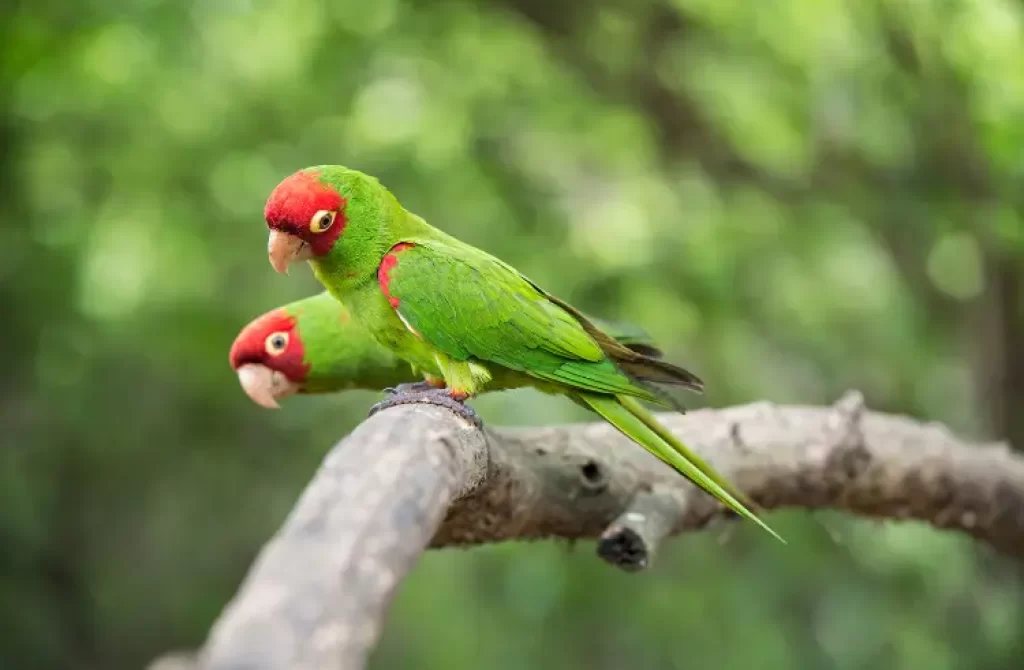
The Red-masked Parakeet boasts a distinctive and unforgettable appearance, marked by captivating features that set it apart in the avian world.
Resplendent Red Mask: A Signature Feature
A defining feature of the Red-masked Parakeet is its resplendent red head, bestowing upon it both its common name and an air of captivating allure.
This remarkable crimson mask sweeps elegantly from the bird’s forehead, down to its cheeks, creating a vivid and enchanting contrast that ignites fascination.
The vibrancy of this red headpiece serves as a striking juxtaposition to its lush, emerald-green plumage, rendering the Red-masked Parakeet a vivid masterpiece of nature’s artistry.
It is in this arresting visual contrast that the bird’s individuality is most pronounced, capturing the attention and admiration of those fortunate enough to encounter it in the wild.
Vivid Red Mask: The Red-masked Parakeet’s stunning red facial mask is like its own little red carpet event in the rainforest. 🌟
Tapered Tail and Elegant Plumage
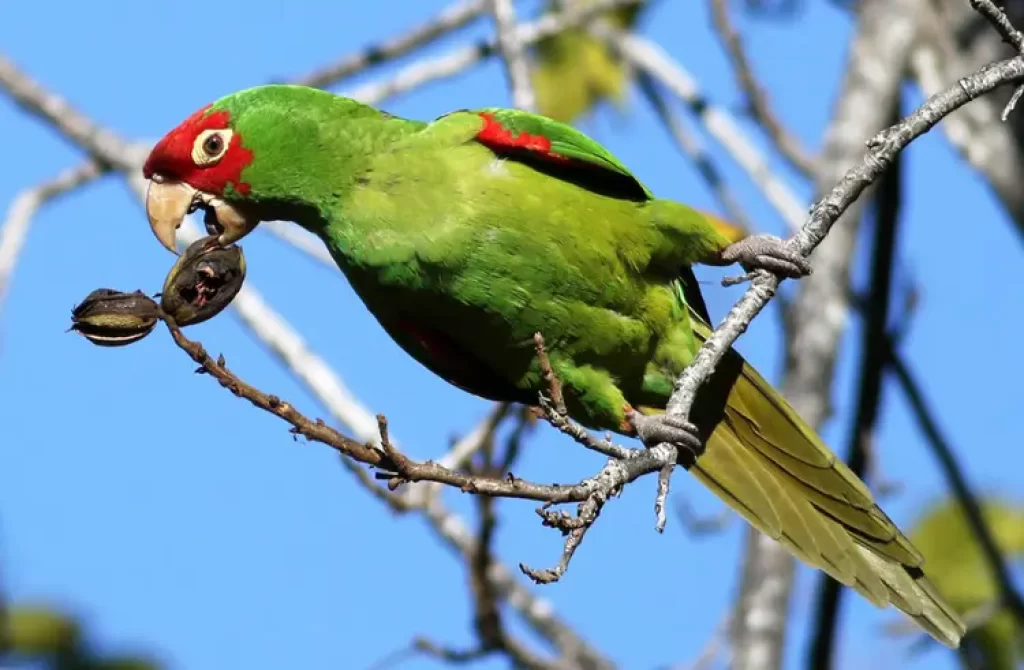
Complementing its vivid red mask are a long, tapered tail and elegant flight feathers that enhance its overall allure. These features contribute to its graceful and agile flight, enabling it to navigate the intricate rainforest canopies with remarkable finesse.
Size: Adaptation in Miniature
The Red-masked Parakeet, measuring around 13 inches (33 cm) in length, epitomizes the mid-sized class among its parakeet counterparts. This unassuming stature is a testament to its evolutionary finesse, affording it the agility required to masterfully navigate the intricate tapestry of rainforest terrain.
In the dappled light of its lush tropical habitat, this modest size becomes an advantage, enabling it to deftly weave through the dense vegetation and explore the vibrant layers of its verdant world.
Fun fact: Don’t let their size fool you; Red-masked Parakeets are the Cirque du Soleil performers of the bird world, effortlessly navigating through the rainforest treetops. 🤸♂️🌳
Natural Habitat
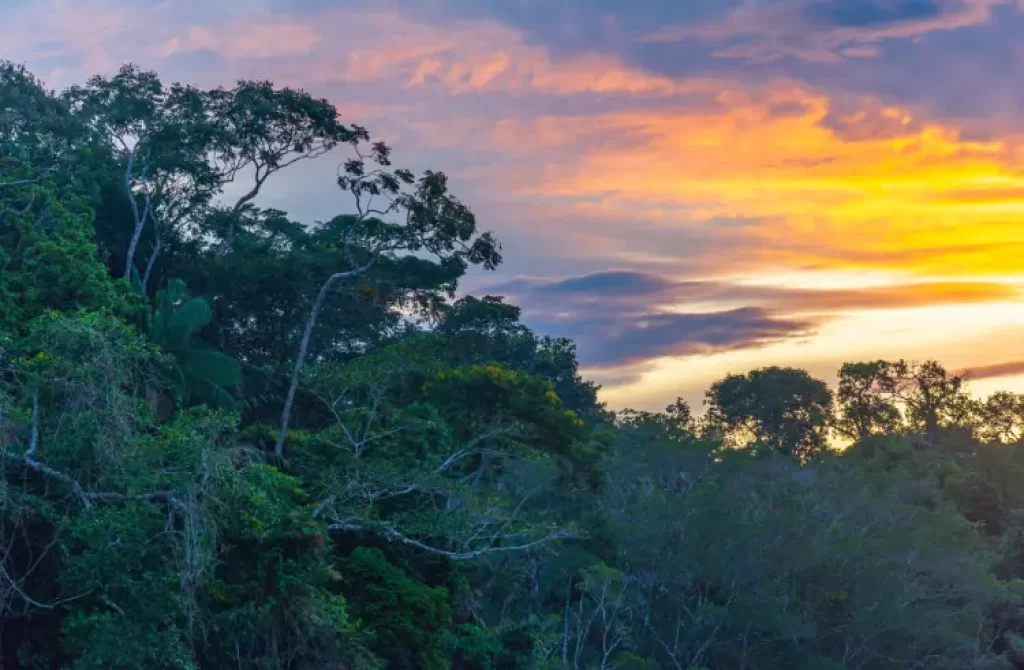
The Red-masked Parakeet, known for its vibrant plumage and captivating presence, calls the enchanting landscapes of South America its home. Within this region, the parakeets are primarily found in the western realms of Ecuador and the northwestern reaches of Peru.
Tropical Rainforests: Lush Havens
Red-masked Parakeets share a profound connection with the pulsating life force of tropical rainforests. These biodiverse wonderlands provide them with cherished sanctuaries, where they revel in the opulence of luxuriant vegetation and the nurturing embrace of life-sustaining rainfalls.
Within the heart of these majestic ecosystems, these parakeets find their place amidst a symphony of biodiversity, thriving amidst the vibrant tapestry of life that surrounds them.
Subtropical Bliss: Climate Fit for Life
Nestled within South America’s humid subtropical climate, the Red-masked Parakeets find a haven for their vibrant existence.
This region offers the ideal blend of warmth and moisture, creating a symphony of conditions that supports their flourishing. With consistently mild temperatures throughout the year and well-distributed rainfall, these parakeets revel in a comfortable environment.
The reliable moisture ensures lush vegetation and abundant food sources, while the temperature range remains moderate. In this subtropical paradise, the Red-masked Parakeets thrive, their colorful plumage reflecting the harmony of nature that surrounds them.
Montane Cloud Forests
These birds, with their adventurous spirits, often seek refuge in montane cloud forests and the adjacent areas.
Elevating their homes to altitudes ranging from 1,000 to 3,000 meters (3,280 to 9,842 feet) above sea level, they showcase their adaptability to diverse altitudes and habitats.
Elevation Dynamics
The Red-masked Parakeet’s presence across this expansive altitudinal range is a testament to their remarkable ability to adapt and thrive in environments ranging from the vibrant lowland rainforests to the misty heights of the montane cloud forests.
This adaptability reflects their resilience and underscores the intricate relationship between these captivating birds and the captivating landscapes they call home.
Behavior and Social Structure
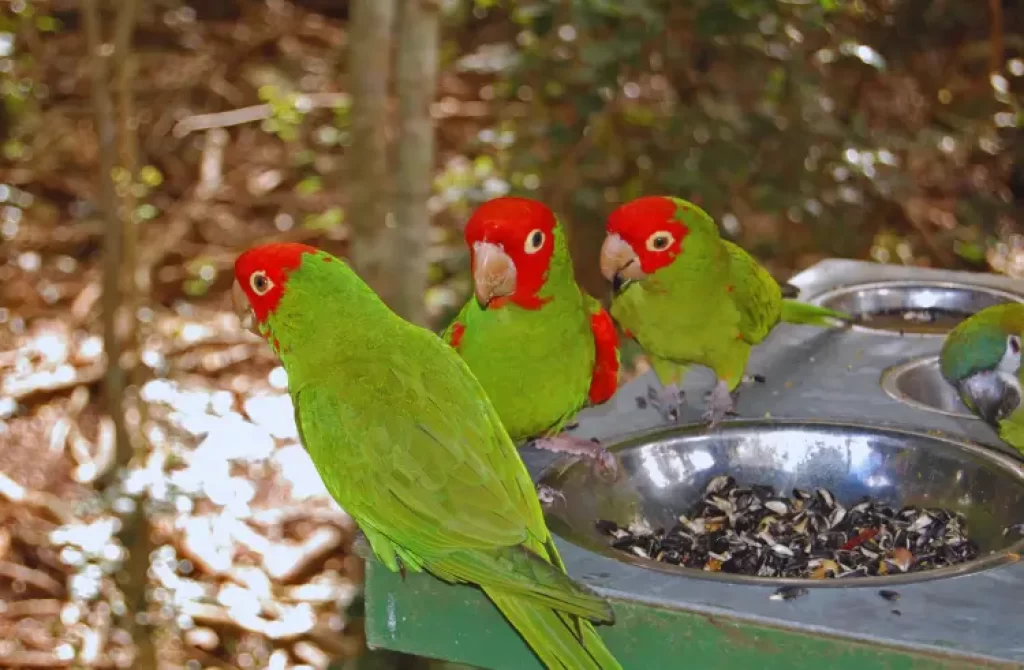
The Red-masked Parakeet is renowned for its gregarious nature. Flocks of these parakeets are a common sight in the rainforests, where they engage in vibrant social interactions.
They are highly vocal, with their calls and squawks resonating through the canopy as they communicate with one another.
These parakeets often forage in groups, which not only provides them with safety in numbers but also allows them to share valuable information about food sources and potential threats.
How do Red-masked Parakeets obtain their food in the wild?
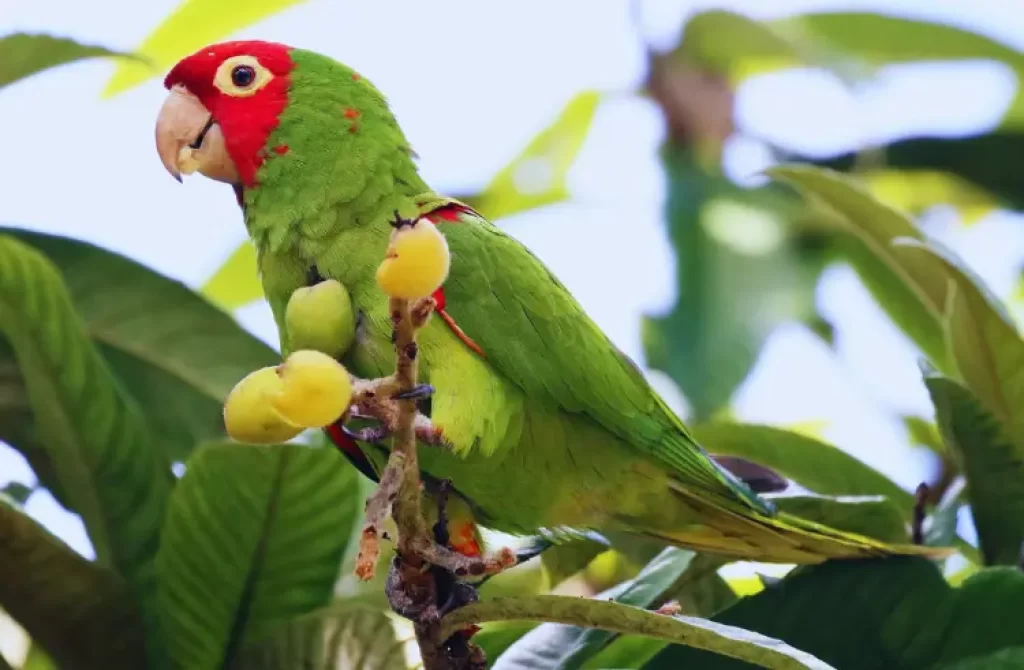
Red-masked Parakeets, like many parrot species, have adapted to a varied diet in the wild. Their foraging behavior is diverse, allowing them to obtain food from various sources in their South American rainforest habitats. Here’s how they obtain their food:
Fruit Eaters
Red-masked Parakeets primarily feed on fruits. They use their strong, curved bills to crack open fruit shells and access the pulp and seeds inside. Their diet includes a wide range of fruits from trees and bushes, and they often feed in the treetops.
Seed Eaters
In addition to fruits, these parakeets consume seeds from various plant species. They are particularly fond of palm fruits and seeds, which they extract using their dexterous bills.
Flower Nectar
Red-masked Parakeets have specialized tongues that allow them to feed on flower nectar. They play a role in pollination as they visit flowers to feed on nectar, transferring pollen from one bloom to another in the process.
Leaves and Buds
Although less common, Red-masked Parakeets may also nibble on leaves and buds. They use their bills to pluck tender plant parts, and this behavior is often seen during certain times of the year.
Insects
On occasion, these parakeets may include insects in their diet, particularly during the breeding season when they need additional protein for themselves and their chicks.
Minerals
Red-masked Parakeets, like many parrots, may ingest minerals and clay from exposed riverbanks or mineral-rich soil. This behavior, known as geophagy, helps them digest toxins found in some of the seeds they consume.
Their flexible diet and ability to utilize a wide range of food sources contribute to their adaptability and success in their subtropical rainforest habitats. This dietary flexibility also allows them to adjust their foraging behavior depending on food availability throughout the year.
Speech and Sounds
The vocal expressions of Red-masked Parakeets are a fascinating aspect of their behavior. These parakeets are known for their lively and engaging calls, which contribute to the vibrant soundscape of their subtropical habitats.
Social Chatter
Red-masked Parakeets are highly social birds, and their vocalizations are a primary means of communication within their flocks.
Their social chatter consists of a variety of melodic and high-pitched calls, often serving to maintain group cohesion and alert others to food sources or potential threats. This constant chatter creates a lively ambiance in the rainforests they call home.
Contact Calls
Contact calls are essential for these parakeets to stay connected with flock members, especially when they are out of sight.
These calls are typically short and sharp, allowing them to keep in touch while foraging or exploring their surroundings. It’s a way for them to ensure they are close to their companions.
Alarm Calls
Red-masked Parakeets are vigilant birds, and they have specific alarm calls to warn their flock about potential dangers.
These alarm calls are sharp and loud, signaling others to be cautious and take cover. It’s a crucial part of their survival strategy, helping them avoid predators.
Courtship Songs
During the breeding season, male Red-masked Parakeets often engage in courtship songs and displays to attract a mate. These songs are more musical and melodious than their usual calls, and they are performed with great enthusiasm.
The female may respond with her own calls and displays if she is interested, marking the beginning of their pair bonding.
Mimicry
Red-masked Parakeets are known for their ability to mimic sounds from their environment, including the calls of other bird species. This mimicry can serve various purposes, from confusing potential predators to adding diversity to their vocal repertoire.
Fun fact: These parakeets are the life of the rainforest party, filling the canopy with their lively chatter. They might just be the original tropical party animals! 🎉🎵
Breeding and Nesting
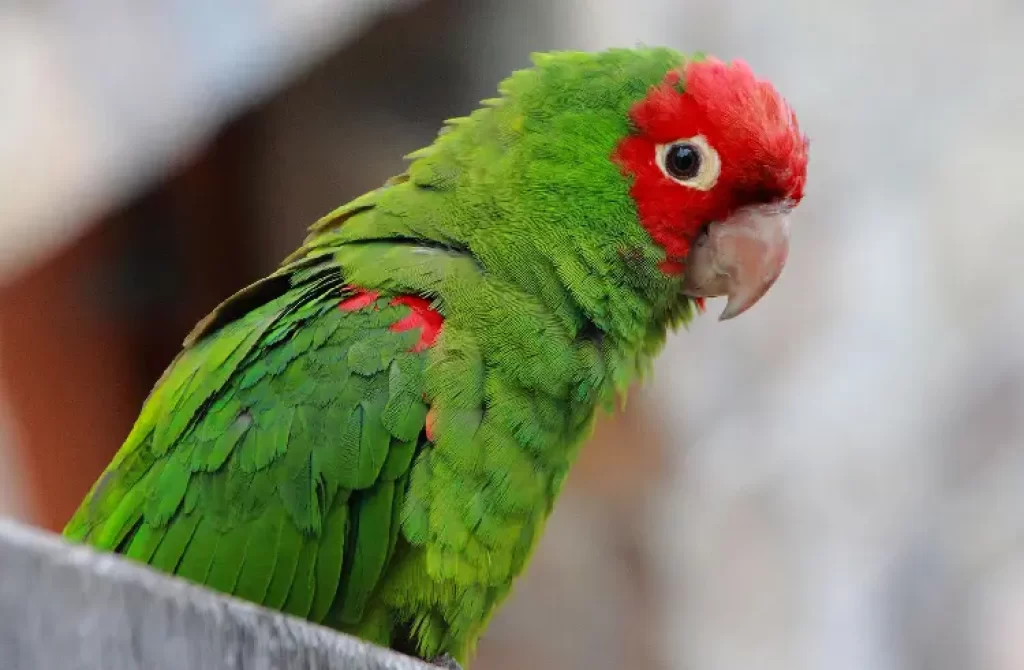
Red-masked Parakeets exhibit a fascinating breeding and nesting behavior intricately woven into the rhythms of their rainforest habitats.
Their breeding season harmoniously coincides with the onset of the rainy season, a testament to the remarkable synchrony of nature.
During this pivotal time, pairs of these parakeets form enduring monogamous bonds, a symbol of fidelity in the wild.
Together, they embark on a quest to discover the ideal nesting sites that will serve as the cradle for their future generations.
Their search often leads them to tree cavities or abandoned woodpecker holes, spaces shaped by nature’s forces and opportunely selected by these ingenious parakeets. With dexterity, they skillfully adapt these hollows to cater to their specific nesting requirements.
Upon settling into their chosen sanctuary, the female Red-masked Parakeet proceeds to lay a clutch of eggs, typically numbering between three and five.
These delicate eggs symbolize the promise of new life, a testament to the cycle of renewal in the heart of the rainforest.
What sets these parakeets apart is their commitment to shared parenting. Both the male and female diligently take turns incubating the eggs and providing attentive care once the chicks emerge into the world.
This collaborative approach to raising their young underscores their profound dedication to ensuring the survival and prosperity of their offspring, a testament to the cooperative spirit that thrives in the heart of the lush rainforest.
Conservation Status
The Red-masked Parakeet, like many other species in the region, faces various conservation challenges. While the parakeet’s population is relatively stable, it is not immune to the threats that many rainforest species confront.
One of the primary threats to the Red-masked Parakeet is habitat loss due to deforestation and land development.
As rainforests are cleared for agriculture, logging, and human settlement, the parakeets lose critical nesting and foraging areas.
Conservation efforts are crucial to safeguard the parakeet’s habitat and ensure the survival of this species in the wild.
Can Red-masked Parakeets be kept as pets?
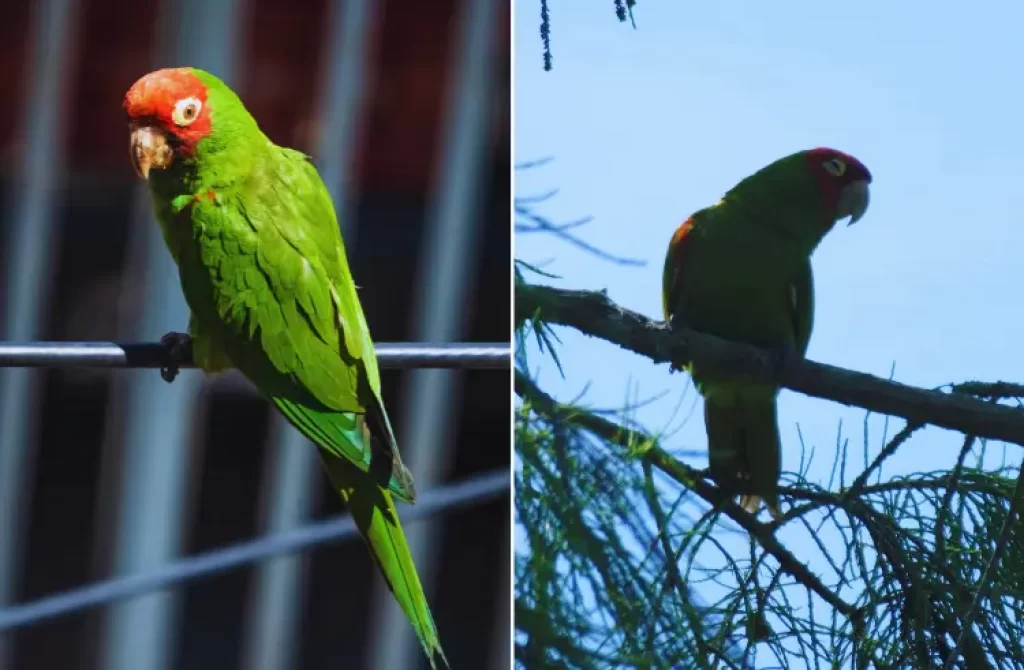
Yes, Red-masked Parakeets can be kept as pets. They are known for their vibrant colors and sociable nature, making them popular among bird enthusiasts.
However, potential pet owners should be aware of their specific care requirements. Red-masked Parakeets need spacious cages, daily social interaction, a balanced diet, and mental stimulation.
They are also known for their vocal nature, so be prepared for their loud calls. Proper care and attention are essential for these birds to thrive as pets. Additionally, it’s crucial to ensure that they are obtained through legal and ethical means, such as reputable breeders or adoption from bird rescue organizations.
Health and Common Conditions
Red-masked Parakeets, like all parrots, require proper care to maintain good health. Common health issues include respiratory infections, feather plucking, and obesity. To ensure their well-being, provide a balanced diet, with fresh fruits, vegetables, and high-quality pellets.
Supplement with essential vitamins and minerals, particularly calcium and vitamin D3. Maintain a clean and spacious cage with plenty of mental stimulation through toys and interaction. Regular exercise, social interaction, and veterinary check-ups are crucial. Watch for feather health and external parasites.
Human Interaction and Cultural Significance
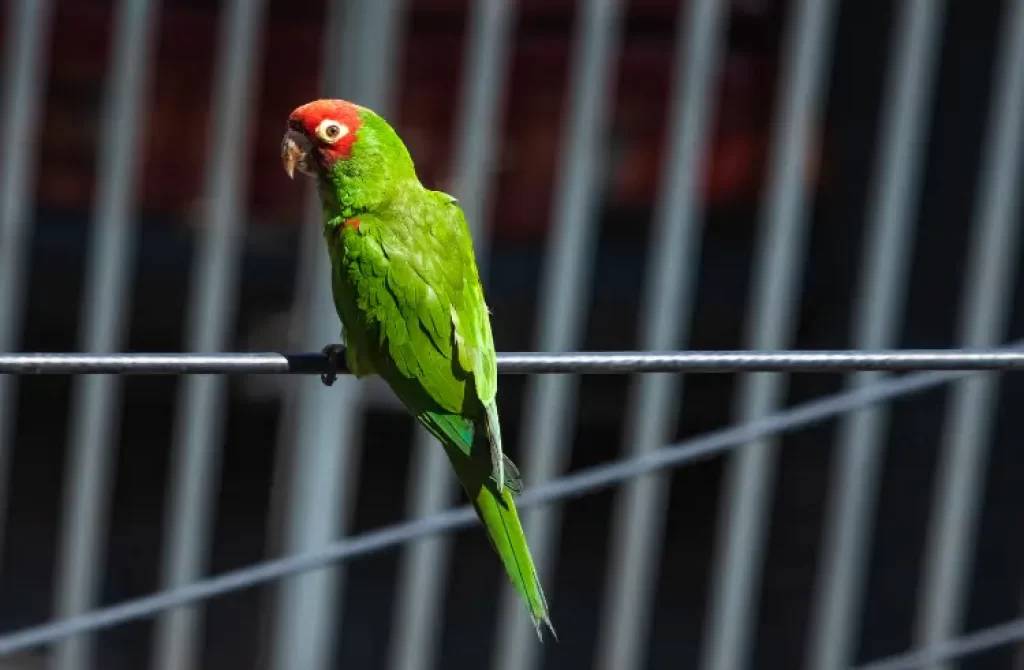
The Red-masked Parakeet holds cultural significance for indigenous communities in its native range. Some communities revere these birds for their vibrant plumage and playful behavior, considering them to be harbingers of rain and fertility.
These parakeets have also found their way into the pet trade due to their striking appearance and engaging personalities.
However, it is essential to approach the trade in exotic birds with caution, as capturing and trading wild parakeets can have detrimental effects on their populations.
You might also like: 13 Owl Species in Michigan & Where to Find Them
Observing the Red-masked Parakeet
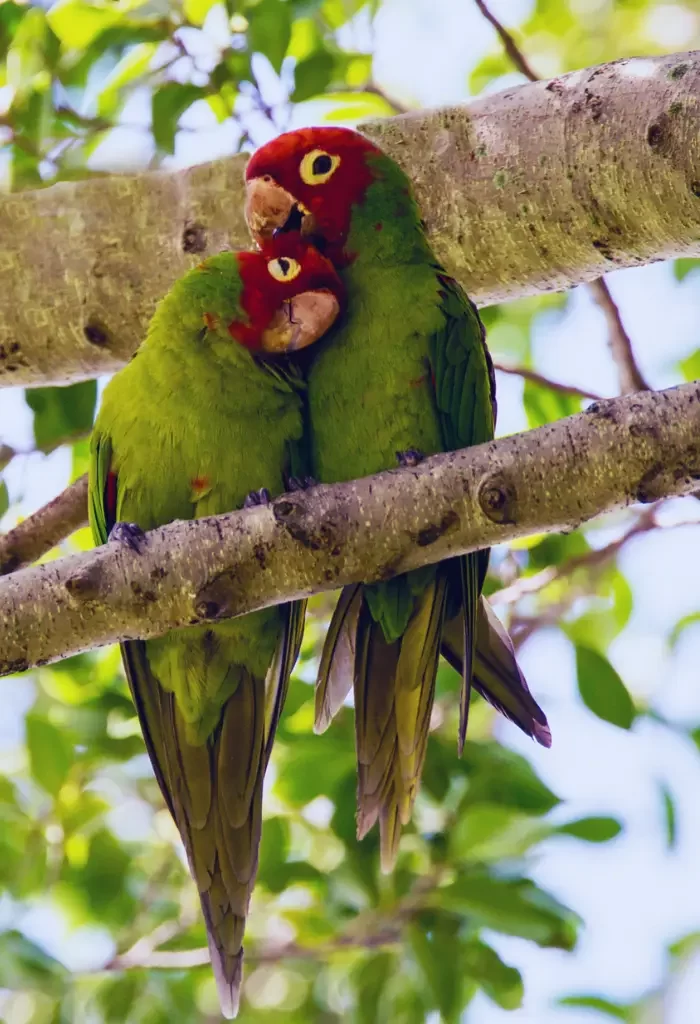
For bird enthusiasts and eco-tourists, the opportunity to observe the Red-masked Parakeet in its natural habitat is a thrilling experience.
Several eco-lodges and wildlife reserves in Ecuador and Peru offer guided tours that provide a glimpse into the world of these charismatic parakeets.
While exploring the rainforests of South America, keep an ear out for their raucous calls and watch for flashes of red among the green canopy.
With patience and a bit of luck, you may find yourself face to face with the captivating Red-masked Parakeet, a living jewel of the rainforest.
Wrapping things up…
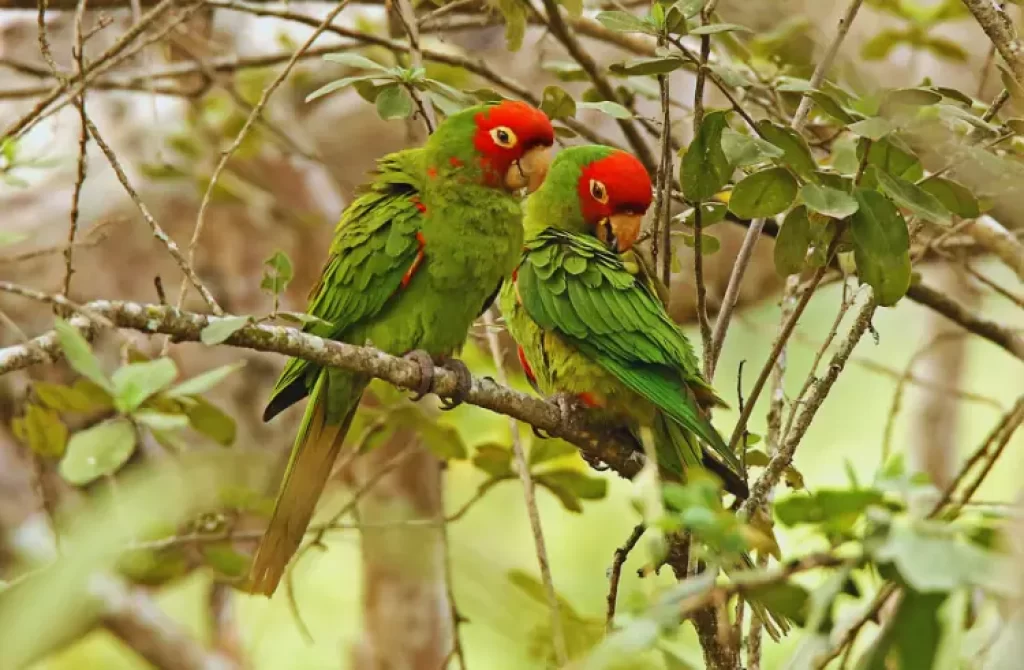
In conclusion, the Red-masked Parakeet’s striking appearance and presence in South America’s rainforests make it a captivating subject for nature enthusiasts and an essential part of the region’s biodiversity.
As efforts to conserve these vital ecosystems continue, this vibrant parakeet serves as a reminder of the beauty and importance of our planet’s natural treasures.
FAQ
Are red masked parakeets endangered?
No, Red-masked Parakeets are not considered endangered. Their conservation status is categorized as “Least Concern” by the International Union for Conservation of Nature (IUCN).
This classification indicates that their populations are stable and not currently facing significant threats or a risk of extinction.
However, like many wild bird species, they may face localized threats due to habitat loss and other factors in certain regions, but overall, they are not considered to be in immediate danger of extinction.
What is the Red-masked Parakeet’s scientific name?
The Red-masked Parakeet’s scientific name is Psittacara erythrogenys.
How did the red masked parakeet get to Hawaii?
The presence of Red-masked Parakeets in Hawaii is believed to be the result of escaped or released pet birds. These parakeets are not native to Hawaii, but they have established feral populations on the islands. It’s common for pet birds, including parakeets, to escape from captivity or be intentionally released by their owners.
When this happens, they may adapt to local environments and reproduce, leading to the establishment of feral populations. This is likely how Red-masked Parakeets, originally from South America, came to inhabit Hawaii.
How do they stay camouflaged in the rainforest?
Red-masked Parakeets, with their vibrant red faces and heads, do not rely on camouflage in the rainforest. Instead, their colorful appearance serves other purposes.
They use their striking red plumage for purposes like attracting mates and signaling their presence to other members of their flock. In the dense greenery of the rainforest, their bright colors can help them stand out visually to their fellow parakeets.
These birds are highly social and often found in groups, so their distinctive coloring may facilitate communication and recognition among flock members rather than providing camouflage in the traditional sense.
Up next
Kenno Marques is a self-taught English speaker deeply passionate about nature and wildlife. He dedicates his time to scouring the web for the latest animal news and engaging content, which he shares on various websites. Fluent in three languages, Kenno is currently on a journey to master German. His commitment to fostering an understanding of the natural world makes him a valuable contributor to the online community.





